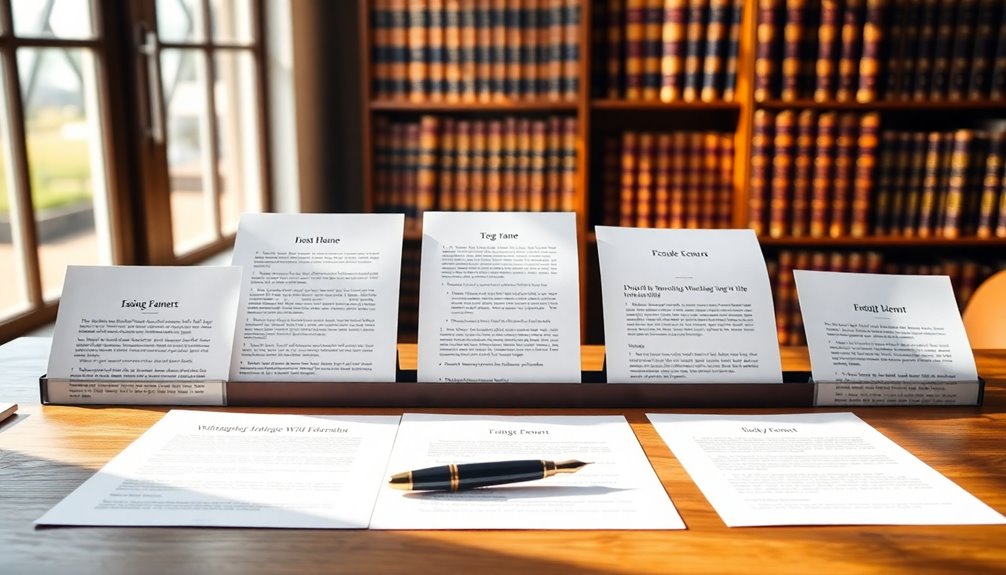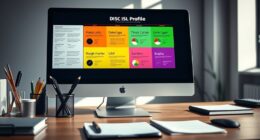When preparing writing samples for your job interview, it's essential to choose examples that showcase your skills effectively. Think about including various formats, like blog posts, press releases, or how-to guides, tailored specifically for the job. Highlight your ability to align with the company's tone and audience by researching their brand. Make sure your samples are well-structured with a clear introduction and conclusion, and don't overlook the importance of editing for a polished finish. These tips will set you apart in interviews, and there's even more valuable information you can explore to help you impress potential employers.
Key Takeaways
- Showcase a variety of writing formats like blog posts, press releases, and how-to guides to demonstrate versatility.
- Tailor samples to the specific job by incorporating relevant skills and keywords from the job description.
- Structure samples with a clear introduction, organized ideas, and a concise conclusion for better readability.
- Ensure all writing samples are professionally edited and free from errors to create a positive impression.
- Include a brief cover letter with each submission to express enthusiasm and provide context for your samples.
Understanding Writing Samples

Understanding writing samples is essential for any job seeker in writing-intensive fields. These samples serve as concrete proof of your writing ability, going beyond the claims made in your resume or cover letter. When employers request writing sample examples, they want to see how well you can showcase your writing and meet specific job requirements. A good writing sample demonstrates your writing style, tone, and content quality, all while reflecting the company's brand voice.
Employers will expect you to pay close attention to detail, including grammar, punctuation, and overall presentation. The types of writing samples can vary widely—think blog posts, press releases, or social media content—so it's vital to tailor your samples to the position you're applying for. A well-crafted writing sample can dramatically enhance your chances of landing an interview, as it highlights your ability to perform key writing tasks effectively. In today's competitive job market, knowing how to present your writing samples can set you apart, showcasing not just your skills but also your understanding of the role you're aiming for.
Types of Writing Samples

When you're preparing your writing samples, consider the different types that best showcase your skills. You'll want to include a mix of article formats, creative content, and professional communication to demonstrate your range. Tailoring these samples to the job you're applying for can really make your application stand out.
Article Formats Overview
Writing samples come in various formats, each tailored to showcase your skills and meet specific job requirements. Blog posts are a popular choice, allowing you to demonstrate your ability to engage readers and convey information clearly. Press releases are another effective format, showcasing your skills in concise and persuasive writing, vital for public relations roles.
How-to guides are particularly useful as writing samples, as they illustrate your capacity to instruct and provide valuable insights, which is essential in content writing and education. Case studies enable you to highlight analytical skills and demonstrate your depth of knowledge by examining real-world examples and their outcomes, making them ideal for marketing and consulting positions.
If you're looking to express your unique voice, creative writing samples—like engaging narratives or opinion pieces—can set you apart, especially in journalism and advertising. Each of these formats serves a specific purpose and showcases different aspects of your writing abilities, so choose wisely based on the job you're applying for. Consider what aligns best with the employer's needs and your strengths to make a lasting impression. Additionally, understanding SEO-focused online courses can enhance your writing samples by applying best practices that increase visibility.
Creative Content Examples
Creative content samples are vital for showcasing your unique voice and style in any job application. These writing samples can include various formats like blog posts, listicles, how-to guides, and opinion pieces. Each piece highlights your creativity and ability to engage readers, which is essential in many roles.
In marketing roles, you'll want to demonstrate your persuasive writing skills through samples such as social media posts, email campaigns, and landing pages. These examples should align with the brand voice of the prospective employer, ensuring that your style resonates with their audience.
Additionally, portfolio presentations can effectively illustrate your versatility and adaptability in writing. By including a range of creative writing samples, you show potential employers that you can tackle different formats and topics with ease.
Make sure your samples are polished and error-free, as this reflects your attention to detail. Remember, engaging writing samples not only showcase your creative flair but also your ability to communicate effectively in a manner that captivates and persuades. Tailoring your submissions to the specific audience will certainly leave a lasting impression. Furthermore, leveraging freelance platforms can help you find varied writing opportunities that align with your skills and interests.
Professional Communication Samples
In many professions, showcasing your ability to communicate effectively in a professional context is just as important as demonstrating your creativity. Professional communication samples, such as emails, memos, reports, and presentations, reveal your writing style and purpose. When you're writing your sample, pay close attention to tone and structure to guarantee clarity and coherence.
Tailored content that reflects the company's brand voice and meets audience expectations can greatly enhance the impact of your samples. Including data-driven insights, like statistics or research findings, adds credibility and demonstrates your analytical skills, making your communication more persuasive. Additionally, utilizing predictive analytics can help tailor your communication strategies based on audience behavior and preferences.
Remember, polished and error-free professional communication samples are essential. Clean copy not only reflects your professionalism but also influences hiring decisions. Employers appreciate attention to detail, so double-check your work for any mistakes.
Ultimately, your ability to craft effective professional communication samples can set you apart from other candidates. By focusing on clarity, relevance, and accuracy, you'll show potential employers that you can communicate ideas effectively in a professional setting.
Tailoring Your Sample

A well-crafted writing sample can be your ticket to landing that dream job, so tailoring it to fit the specific role is vital. Start by reviewing the job posting thoroughly. Understand the company's brand and target audience, as this knowledge will help you match the tone and style required. When you're tailoring your sample, make sure to highlight relevant skills and experiences mentioned in the job description. This not only showcases your qualifications but also reinforces your fit for the role.
Incorporate keywords and themes from the job posting into your writing sample. Doing so demonstrates your attention to detail and your ability to follow instructions—traits essential for most writing positions. Additionally, don't hesitate to customize your sample to address specific challenges or goals the company faces. This approach can set you apart from other candidates by showing that you've thought critically about how your writing can add value to their operations. By tailoring your sample effectively, you'll create a compelling case for why you're the ideal candidate for the job.
Analyzing Job Postings

Understanding a job posting's nuances can greatly enhance your writing sample's effectiveness. Start by carefully reviewing job postings to identify the specific writing sample requirements, such as formats, lengths, and relevant topics. Highlight key skills mentioned in the job description; this will allow you to tailor your writing samples to meet those specific needs.
Next, pay attention to any references to the target audience. Aligning your writing sample with the intended demographic can notably boost your appeal to potential employers. Additionally, look for unique language or phrases used in the job ad. These can guide the tone and style of your writing sample, ensuring your work resonates with the company's brand voice.
Lastly, analyze any specific examples requested in the job posting. These examples provide insight into employer expectations regarding content and quality. By adhering to these guidelines, you'll craft writing samples that not only demonstrate your skills but also align perfectly with what the employer is seeking. This strategic approach will set you apart and increase your chances of impressing during the interview process.
Company Research Techniques

To create a compelling writing sample, you need to dive deep into company research. Start by reviewing the company's website to understand its mission, values, and product offerings. This guarantees your writing sample aligns with the company's brand and objectives. Next, analyze social media to grasp the tone and style used in their communications. This insight is essential for meeting employer requests and resonating with the audience.
Utilize tools like Glassdoor and LinkedIn to gather insights about company culture and employee experiences. These resources can inform the voice of your writing sample, helping you connect with the company's ethos. Don't overlook recent news articles or press releases; they can reveal current projects, challenges, or successes relevant to your writing.
Finally, research target audience demographics by examining the company's customer base and preferences. Understanding who they serve enables you to tailor your writing to meet specific needs and interests. By employing these company research techniques, you'll enhance your writing sample's relevance and impact, making your job application stand out in a competitive landscape. Additionally, consider how early socialization can play a role in shaping your understanding of the company's clients and their interactions with the brand.
Brainstorming Writing Ideas

When brainstorming writing ideas, start by generating creative concepts that align with the company's mission and audience interests. It's crucial to evaluate the relevance of these ideas to guarantee they resonate with current trends and your personal expertise. By combining fresh thoughts with your unique insights, you can create compelling writing samples that stand out.
Generating Creative Concepts
Generating creative concepts for your writing samples can feel overwhelming, but using effective brainstorming techniques makes the process much easier. Start by brainstorming writing ideas that resonate with your target audience and align with the company brand voice. This guarantees your concepts are relevant and engaging.
Try techniques like mind mapping or free writing to stimulate your creativity. These methods can help uncover unique angles or topics that you might not have considered initially. Collaborating with peers or mentors during brainstorming sessions can also provide fresh perspectives, fostering innovative ideas that elevate your writing sample's quality.
Don't overlook the importance of researching industry trends and competitor content. This research can inspire new ideas and assure your writing sample addresses current issues or interests within the field. Additionally, keep an idea journal to capture spontaneous thoughts and inspiration. This dedicated space becomes a valuable resource when you're seeking topics for your writing samples, allowing you to generate a diverse range of creative concepts that stand out. By employing these strategies, you'll not only enhance your brainstorming process but also create compelling writing samples that impress potential employers.
Furthermore, being aware of key trends in AI can spark innovative angles for your writing samples that resonate with emerging industry demands.
Evaluating Idea Relevance
Evaluating the relevance of your brainstorming ideas is vital for crafting impactful writing samples. As you navigate your job search, you need to guarantee that your content aligns with the specific themes and objectives outlined in the job description. Start by considering your target audience's preferences and interests; this will help you select topics that resonate and engage them effectively.
Use techniques like mind mapping or free writing to generate a broad range of creative ideas. Once you've brainstormed, it's time to evaluate idea relevance. Prioritize concepts that not only match the job requirements but also showcase your unique perspective or expertise. This will set your writing samples apart from others.
Additionally, researching industry trends and existing content is significant. It gives you insights into what topics are currently enthralling readers, allowing you to develop timely and relevant writing ideas. By focusing on these aspects, you can refine your brainstorming writing ideas into compelling pieces that truly stand out during your job search. Remember, the goal is to create samples that are not just relevant, but also leave a lasting impression.
Moreover, incorporating elements of continuous learning can enhance the depth of your writing samples, showcasing your adaptability and commitment to growth.
Structuring Your Sample

Structuring your writing sample effectively can make a significant difference in how it's received by potential employers. To create an impactful writing sample, follow these three key steps:
- Strong Introduction: Start with a compelling hook that captures the reader's attention. Clearly outline the main points you'll discuss, setting the stage for what's to come.
- Body of the Sample: Organize your ideas logically. Use subheadings and bullet points to break up text and enhance readability. This structure helps your audience follow along easily and keeps them engaged.
- Conclusion: Wrap up your sample by summarizing key insights. Reinforce your main message and provide a clear takeaway for the reader.
Remember to adhere to any specified formatting and length requirements from the job posting. A well-structured writing sample not only showcases your skills but also demonstrates your attention to detail. Finally, consider incorporating a call-to-action (CTA) at the end. This encourages potential employers to engage further with your content and leaves a lasting impression.
Importance of Editing

After crafting a well-structured writing sample, the next vital step is editing. This process guarantees your writing samples are free from typos, grammatical errors, and syntax issues that could undermine your professionalism. Mistakes in your final product can lead hiring managers to question your attention to detail.
Using the 5-Round editing formula can help you refine your work effectively. Start by improving the content, then focus on the writing quality, compliance with job ad requirements, and optimization for SEO. Multiple rounds of editing enhance clarity and coherence, making certain your sample aligns with the job description and the company's brand voice.
Don't underestimate the value of peer feedback during this process. Others can offer insights that you might overlook, helping you identify areas for improvement. Investing sufficient time in editing is essential; thorough reviews can elevate your writing sample from average to outstanding. Remember, a polished writing sample notably increases your chances of making a positive impression on hiring managers. So, embrace the editing phase—it's where your work truly transforms into a compelling showcase of your skills.
Finalizing Your Submission

Before you send off your writing sample, take a moment to polish your content and verify it meets the submission format guidelines. Check that it fits the specified length and is free from errors that could undermine your professionalism. Finally, save it in the requested format to make a strong impression on your potential employer.
Polishing Your Content
To guarantee your writing sample stands out, meticulously proofread it for grammar, punctuation, and spelling errors. This attention to detail reflects professionalism and enhances your credibility as a candidate. Here are three key steps to polish your content before submission:
- Align with Job Requirements: Make sure your final version meets the specified formats, length, and style indicated in the job posting. Tailoring your writing samples to the employer's expectations demonstrates your commitment.
- Incorporate Feedback: Seek insights from peers or mentors during the final review process. Constructive feedback can help refine clarity and coherence, ensuring your content resonates with the intended audience.
- Maintain Consistent Tone and Voice: Your writing sample should reflect the company's branding. Consistency in tone and voice is essential for portraying yourself as a fitting candidate. Additionally, be mindful of emotional dysregulation that can affect how your writing is received, as clarity is key in communication.
Submission Format Guidelines
Submitting your writing sample correctly is essential for making a positive impression on potential employers. First, verify your submission format aligns with the job requirements. Check the job ad for any specified length, usually between 1 to 5 pages. This adherence shows you can follow instructions.
Next, your writing sample must be polished and free of errors. Typos and grammatical mistakes can undermine your professionalism and attention to detail. To give hiring managers a realistic view of your work, use formats that mirror potential publication platforms like WordPress or LinkedIn Publishing, which reflects a professional setting.
Don't forget to include a brief cover letter with your writing sample. This document provides context, allowing you to highlight how your skills align with the job requirements. It's a valuable opportunity to express your enthusiasm and suitability for the role.
Lastly, after submitting your writing sample, follow up with the hiring managers. This gesture showcases your continued interest in the position and professionalism while keeping you open to feedback for future applications. By following these guidelines, you'll enhance your chances of leaving a lasting impression.
Follow-Up Strategies

Following up after you've submitted your writing sample can really set you apart in the hiring process. It shows your enthusiasm and professionalism. Best practice suggests you should follow up within a week. A brief email to the hiring manager can reinforce your interest and help you inquire about your application status. Here are three effective follow-up strategies:
- Send a Polite Email: Craft a concise message highlighting your excitement about the position and ask about the application status. This reflects your professional communication skills.
- Track Follow-Up Efforts: Keep a record of your follow-up dates and responses. This helps you stay organized and prevents overwhelming the hiring manager with too many inquiries.
- Make a LinkedIn Connection: If you haven't already, connect with the hiring manager on LinkedIn. This enhances your visibility and keeps you on their radar during the evaluation process. Additionally, consider utilizing real-time analytics to assess the effectiveness of your follow-up strategies and adjust accordingly.
Frequently Asked Questions
What Is a Good Writing Sample for a Job Interview?
A good writing sample for a job interview showcases your relevant skills and aligns with the job description. It should be concise, ideally between 1 to 5 pages, emphasizing clarity and professionalism. Tailor your sample to reflect the company's brand voice and target audience. Including various formats, like articles or reports, demonstrates versatility. Finally, guarantee it's well-edited, free from errors, to convey your attention to detail and reliability.
What Is a Short Writing Sample?
What makes a short writing sample effective? A short writing sample is a concise piece, usually between 100 to 500 words, that showcases your communication skills. It should be clear and engaging, reflecting your writing style and tone. You might include emails, social media posts, or brief articles that align with your audience's interests. Focus on clarity and coherence, ensuring it meets any guidelines provided for the best impression.
What Should I Write in My Writing Sample?
When you're deciding what to write in your sample, focus on a topic that showcases your skills and aligns with the job you're applying for. Choose something relevant to the company's industry and audience, and make sure it reflects the tone they're looking for. Incorporate real-world examples to demonstrate your expertise, and keep it concise—ideally between 1 to 5 pages. Finally, don't forget to proofread for clarity and errors!
How to Write a Work Sample?
To write a work sample, start by reviewing the job description to understand the specific expectations. Create an outline to organize your thoughts clearly. Draft your piece without stressing over perfection, then refine it through several editing rounds. Pay attention to grammar and formatting to meet the requirements. Finally, seek feedback from peers to gain insights and improve the quality of your work sample before submitting it.
Conclusion
Now that you have the tools to craft an impressive writing sample, imagine the opportunities that await you. Picture your future employer reading your work, nodding in approval, and seeing you as the perfect fit for their team. But remember, it's not just about writing—it's about connection. Will your words resonate? Will they leave a lasting impact? As you finalize your submission, keep those questions in mind. Your next big break could be just a well-crafted sample away.
Felicity, our Author, pens in-depth articles and guides that delve into the heart of personal discovery. Her narrative-driven approach weaves together theory, practice, and personal anecdotes, making the journey of self-exploration both relatable and inspiring. Felicity’s contributions help illuminate the path for those seeking a deeper understanding of themselves and their relationships.










